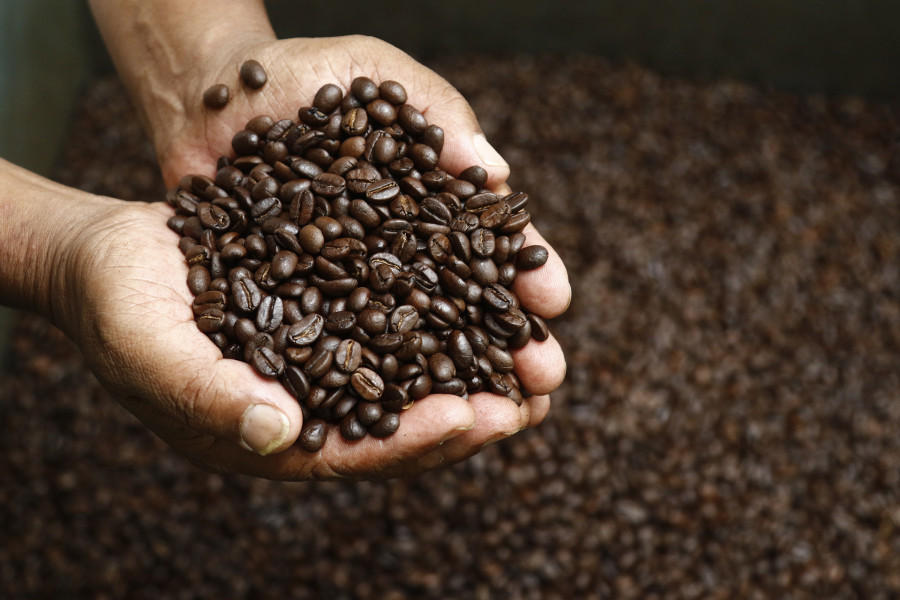Money
Coffee sector performing below potential due to archaic ways
Government incentives to farmers can help boost output, experts say.
Himendra Mohan Kumar
Nepal has the potential to become a regional powerhouse for organic specialty coffee, but one harvest a year, primitive farming techniques and inadequate government support are posing impediments in the sector’s growth, experts say.
“Unlike Brazil and Columbia, coffee farming practices in Nepal are not mechanised, which results in lower coffee yields, and also there’s no grading at the farm level, which affects the quality of the final coffee product,” Gaurav Luitel, agriculture development officer at the National Tea and Coffee Development Board, told the Post.
In Brazil and Indonesia, there are two coffee harvests annually, Luitel said. Inadequate support from the federal government for new plantations and mechanisation has contributed to Nepal not realising its full potential in coffee cultivation, he added.
Although Nepal is endowed with the right topography and climatic conditions for commercial coffee cultivation, experts said the cost of local produce is way too high and yields abysmally low by international standards as a result of cultivation being mostly in the hands of subsistence farmers with small landholdings. The average size of coffee farms in Nepal is less than one ropani, which is too small to achieve economies of scale.
“Due to traditional subsistence farming techniques, a Nepali coffee farmer, on average, is able to produce only about 300 kg of coffee per ropani as compared to around 1,400-1,500 kg per ropani in India,” said Raj Kumar Banjara, president of the National Coffee Academy.
Nonetheless, a higher profit margin in coffee farming, given the burgeoning local demand and the support price of Rs85 per kg for Grade A fresh cherry fixed by the government, is helping Nepali farmers keep its viability.
“The cost of producing Nepali coffee is quite high, and it may be due to various factors, including difficult geographical terrain, lack of modern farming techniques and a low volume of harvest,” said Banjara.
Banjara, who is a local coffee producer and exporter himself, said the bulk of Nepal’s coffee production is being exported to Europe, the United States and Japan with average green beans export prices ranging anywhere between $10 to $12 per kg. Additionally, there is also a strong local demand for Nepali coffee, which currently stands at about 80 tonnes a year and is growing at an annual rate of almost 25 percent.
Nepal’s total coffee production was 530 tonnes in the last fiscal year, and during the current fiscal year, output may be as high as 600 tonnes according to coffee board estimates, said Luitel.
Raju Dhakal, a small-scale farmer cultivating three ropanis of land in Kabhre district, said that ordinarily, he plants coffee, maize, potato and wheat on his farm every year, but it’s coffee that's fetching him a higher profit each time.
“My profit last year was Rs10,000 per ropani. But I sold 200 kg of coffee at Rs80 per kg in the local market separately, which helped me make some good money,” said Dhakal.
He said the only government help he ever received was a tractor for hire service at a 50 percent discount some six months ago. At that time, he was planting the seeds.
Data from the National Tea and Coffee Development Board shows that until 2000, exports of Nepali coffee totalled just 3.6 tonnes with an export value of Rs673,000. Nearly two decades later, coffee exports had surged exponentially to 82.68 tonnes, generating Rs98.86 million in income. For the next year, the board has set an export target of 150 tonnes.
Deepak Khanal, acting executive director at the National Tea and Coffee Development Board said Nepal’s export volume potential is estimated at 8,000 metric tons a year. But to reach its full export potential, he said the country would need to have up to 2 million hectares of land under coffee cultivation.
At present, the coffee acreage stands at 973 hectares.
“The board has done a study in 10 districts, and it has been able to identify 62,000 hectares of land at elevations ranging between 800 and 1,800 metres above sea level. The identified tracts of land have been found to be highly suitable for growing Arabica coffee,” said Khanal.
He also said that if the local governments and municipalities encourage coffee growing in their respective jurisdictions, over time, more land parcels could be brought under coffee cultivation.
Khanal said the local coffee industry could also benefit from the government allowing foreign investment into the sector. But the country doesn’t have a land leasing policy for foreign companies in the farm sector.
“Foreign investors are wary of the difficulties they may face in leasing land for cultivation, and that’s the reason they are not aggressively coming forward to invest in coffee plantations in Nepal. The Ministry of Agriculture and the Ministry of Commerce need to formulate policies to attract foreign direct investment in commercial coffee cultivation. That would not only help our farmers, it would generate other local employment opportunities too.”
Banjara said a coffee plant is vulnerable to pests and diseases during its lifecycle, and Nepali farmers have to bear the full brunt of any crop loss. “Besides, there is not enough research on coffee varietals. The Nepal government should establish a coffee lab where potential farmers can buy certified coffee seeds and saplings.”
The coffee plants in Nepal are less robust, compared to the Robusta variety grown in other parts of the world, said Luitel.
Every year, there are instances of farmers losing a part or all of their produce to pests like coffee berry borer and white stem borer. Besides, coffee plants are prone to leaf rust, a coffee plant disease, which effectively destroys the crop.
“It’s estimated that nearly 20 percent of Nepal’s coffee crop gets destroyed annually by pests and diseases,” said Luitel.
Tilak Chhetri, plantation manager at a 1,200-ropani coffee estate in Nuwakot, said his crop output next year will probably fall to 50 tonnes from 60 tonnes this year as they need to root out diseased plants. Their plantation, called the Plantec Coffee Estate, produces fresh cherry. The green beans are sent to Kathmandu for export.
“We collect fresh cherry, ferment, then do the pulping, drying, and when we get the order, start hauling,” said Chhetri, explaining the various processes involved in coffee production.
Looking ahead, Banjara said there should be a helpdesk manned by a team of experts to help coffee farmers. “As well, there is an urgent need for a disease control mechanism within the government system.”
Commercial coffee plantations are spread across 32 districts in the middle hills of Nepal. Some districts like Gulmi, Palpa, Arghakhanchi, Lalitpur, Tanahu, Kabhre, Sindhupalchok, Lamjung, Kaski, Gorkha, Syangja, Parbat and Baglung are successfully growing and producing coffee beans, and their output is increasing gradually.
At present, all Nepali coffee is of the Arabica variety, a mix of bourbon, typica and caturra varietals, and is grown above 1,000 metres and up to 1,600 metres.




 14.12°C Kathmandu
14.12°C Kathmandu















